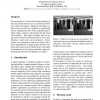Free Online Productivity Tools
i2Speak
i2Symbol
i2OCR
iTex2Img
iWeb2Print
iWeb2Shot
i2Type
iPdf2Split
iPdf2Merge
i2Bopomofo
i2Arabic
i2Style
i2Image
i2PDF
iLatex2Rtf
Sci2ools
VMV
2004
2004
Top-Down Visual Attention for Efficient Rendering of Task Related Scenes
The perception of a virtual environment depends on the user and the task the user is currently performing in that environment. Models of the human visual system can thus be exploited to significantly reduce computational time when rendering high fidelity images, without compromising the perceived visual quality. This paper considers how an image can be selectively rendered when a user is performing a visual task in an environment. In particular, we investigate to what level viewers fail to notice degradations in image quality, between nontask related areas and task related areas, when quality parameters such as image resolution, edge antialiasing and reflection and shadows are altered.
| Added | 31 Oct 2010 |
| Updated | 31 Oct 2010 |
| Type | Conference |
| Year | 2004 |
| Where | VMV |
| Authors | Veronica Sundstedt, Alan Chalmers, Kirsten Cater, Kurt Debattista |
Comments (0)

